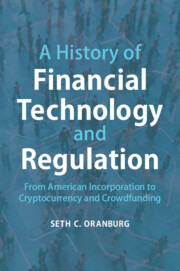 A History of Financial Technology and Regulation
A History of Financial Technology and Regulation Book contents
- A History of Financial Technology and Regulation
- A History of Financial Technology and Regulation
- Copyright page
- Dedication
- Contents
- Figures
- Acknowledgments
- Introduction
- The First Era
- The Second Era
- The Third Era
- 7 The Dot-Com Bubble
- 8 Social Media Activism
- 9 Cryptographic Theory and Decentralized Finance
- 10 Cryptocurrency Regulation
- 11 Crowdfunding
- Conclusion
- Index
- References
7 - The Dot-Com Bubble
from The Third Era
Published online by Cambridge University Press: 24 March 2022
- A History of Financial Technology and Regulation
- A History of Financial Technology and Regulation
- Copyright page
- Dedication
- Contents
- Figures
- Acknowledgments
- Introduction
- The First Era
- The Second Era
- The Third Era
- 7 The Dot-Com Bubble
- 8 Social Media Activism
- 9 Cryptographic Theory and Decentralized Finance
- 10 Cryptocurrency Regulation
- 11 Crowdfunding
- Conclusion
- Index
- References
Summary
The sharp and rigid dichotory between public and private corporations is a hallmark of securities regulation, but it has become outdated. The recent emergence, and dominance, of large private companies—once called “unicorns” for their rarity but now numbering in the hundreds—undermines essential assumptions behind securities regulations. This Chapter explores how the rise of these gargantuan private companies was brought on by the public’s eroding confidence in public companies and exacerbated by an ill-equipped government producing ineffective, reactionary legislation. Specifically, the Penny Stock Reform Act of 1990 and the Sarbanes-Oxley Act of 2002 resulted in a muddied pool of legitimate and fraudulent investment opportunities. Ordinary investors were left clambering for new investment opportunities and have shifted their gaze to the wilderness of the unregulated cryptocurrency market.
Keywords
- Type
- Chapter
- Information
- A History of Financial Technology and RegulationFrom American Incorporation to Cryptocurrency and Crowdfunding, pp. 87 - 95Publisher: Cambridge University PressPrint publication year: 2022
